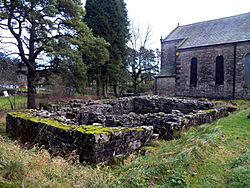Ravenstonedale Priory facts for kids

Priory ruins adjacent to St Oswald's church
|
|
| Monastery information | |
|---|---|
| Full name | Ravenstonedale Priory |
| Order | Gilbertine |
| Established | exact date not known, during reign Henry II, 1145-1189 |
| Disestablished | prob 1539 with Watton |
| Mother house | Watton Priory |
| Diocese | Carlisle |
| People | |
| Founder(s) | Torphin, son of Robert, son of Copsus |
| Site | |
| Location | Ravenstonedale, Cumbria, England |
| Visible remains | Ruin on north side of the church. This was the east range of the cloister |
| Public access | Yes |
Ravenstonedale Priory was a special type of monastery in Cumbria, England. It was founded a long time ago, during the rule of King Henry II (between 1145 and 1189). A man named Torphin gave the land for it. This priory was home to a small group of religious people called Gilbertine canons. The Gilbertine order was unique because it was the only religious order started in England.
Life at the Priory
We don't know much about daily life at Ravenstonedale Priory. It was connected to a larger monastery called Watton Priory in Yorkshire. This connection was important for many years.
Records show there was a disagreement over land with a bishop in the late 1200s. This proves the priory was still active then. Later, around 1336, the church in Ravenstonedale officially became part of the priory.
In 1405, an investigation looked into how the priory was being run. It was said that for some time, the canons (the religious men living there) had not been present. This suggests the priory might have been struggling.
What Happened After the Priory Closed?
Most monasteries in England were closed down in the 1500s. This was known as the Dissolution of the Monasteries. Ravenstonedale Priory likely closed around 1539, at the same time as Watton Priory.
After it closed, the land first went to the Archbishop of York. Then, it was given to the Wharton family. Later, in 1729, the Lowther family bought the land.
People started writing about the priory ruins in the late 1600s. One writer, Machell, described the "cloister court," which was an open area surrounded by buildings. By the early 1700s, most of the ruins had disappeared. A bishop named Nicholson noted that a hidden room, or vault, was still visible. This vault had been used as a prison for people accused of serious crimes by the local court.
Digging Up the Past
Archaeologists have explored the ruins of Ravenstonedale Priory.
In 1928-29, an archaeologist named E. P. Frankland dug at the site. He realized it was the Gilbertine priory. He found the ruins we can see today, plus more foundations that are now covered up again. The priory seemed quite large for the small number of canons thought to live there later on.
More extensive digging happened in 1988-89. This work was done by Cumbria County Council with help from local fundraising and English Heritage. After the digging, the ruins were made more stable so they wouldn't fall apart. The parts you can see now are from the eastern side of the cloister. These parts were probably rebuilt or changed in the late 1200s or 1300s.
Today, there is a sign at the site that explains its history.

